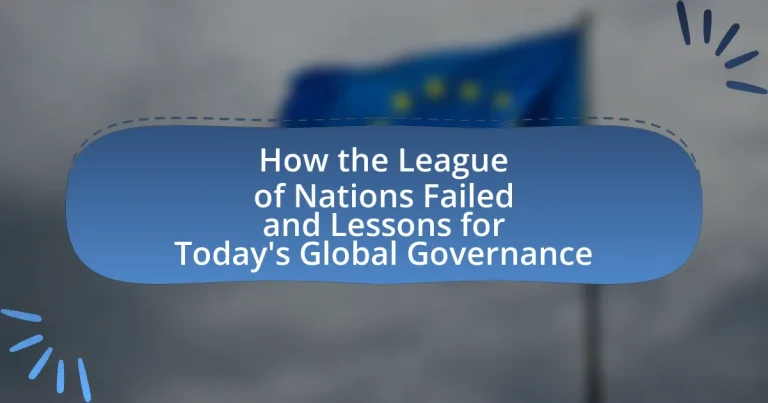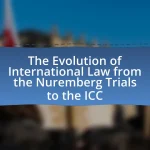The League of Nations, established after World War I to promote peace and cooperation among nations, ultimately failed due to several critical factors. Its lack of enforcement power, absence of key nations like the United States, and inability to address acts of aggression significantly undermined its authority and effectiveness. The article examines the structural weaknesses in the League’s decision-making process, the impact of member states’ non-compliance, and the challenges posed by external conflicts and totalitarian regimes. Additionally, it draws lessons for contemporary global governance, emphasizing the importance of member state commitment, inclusive decision-making, and robust enforcement mechanisms to prevent future conflicts.
What were the main reasons for the League of Nations’ failure?
The main reasons for the League of Nations’ failure include its lack of enforcement power, the absence of key nations, and its inability to prevent aggression. The League lacked a military force to enforce its resolutions, which undermined its authority and effectiveness in resolving conflicts. Additionally, the United States never joined the League, while other major powers like the Soviet Union and Germany were either excluded or withdrew, limiting its influence and credibility. Furthermore, the League’s failure to address acts of aggression, such as Japan’s invasion of Manchuria in 1931 and Italy’s invasion of Ethiopia in 1935, demonstrated its ineffectiveness in maintaining peace and security. These factors collectively contributed to the League’s inability to fulfill its primary mission of preventing war and fostering international cooperation.
How did the League’s structure contribute to its ineffectiveness?
The League of Nations’ structure contributed to its ineffectiveness primarily due to its lack of enforcement mechanisms and the absence of major powers. The League was designed with a collective security principle, but it lacked the authority to enforce its resolutions or impose sanctions, which diminished its ability to respond to aggression. For instance, when Japan invaded Manchuria in 1931, the League condemned the action but failed to take any meaningful action to stop it, showcasing its inability to enforce decisions. Additionally, the absence of the United States, along with the withdrawal of key nations like Germany and Japan, weakened the League’s influence and credibility, as it could not achieve the necessary consensus or military backing to maintain peace. This structural weakness ultimately led to its failure in preventing conflicts and maintaining international order.
What were the key weaknesses in the League’s decision-making process?
The key weaknesses in the League of Nations’ decision-making process included a lack of enforcement power, the requirement for unanimous decisions, and the absence of major powers at critical moments. The League lacked the authority to enforce its resolutions, which undermined its effectiveness in resolving conflicts. Additionally, the requirement for unanimous decisions often led to paralysis, as any member could veto actions, preventing timely responses to crises. Furthermore, the absence of key nations, such as the United States, weakened the League’s legitimacy and influence, as it could not effectively address global issues without the participation of major powers. These structural flaws contributed to the League’s inability to maintain peace and prevent the escalation of conflicts leading up to World War II.
How did the absence of major powers affect the League’s authority?
The absence of major powers significantly undermined the League of Nations’ authority. Without the participation of key nations such as the United States, which never joined, and the Soviet Union, which was excluded initially, the League lacked the political and military strength necessary to enforce its resolutions. This absence led to a diminished credibility and effectiveness in addressing international conflicts, as seen in the League’s inability to prevent aggression from countries like Japan in Manchuria and Italy in Ethiopia. The lack of major powers also resulted in a limited ability to impose sanctions or mobilize collective security measures, further eroding its influence in global governance.
What role did member states play in the League’s downfall?
Member states significantly contributed to the League of Nations’ downfall by failing to uphold their commitments and by prioritizing national interests over collective security. Key examples include the absence of major powers like the United States, which weakened the League’s authority, and the reluctance of member states to impose sanctions or take military action against aggressors, as seen in the cases of Japan’s invasion of Manchuria in 1931 and Italy’s invasion of Ethiopia in 1935. These failures demonstrated the inability of member states to cooperate effectively, ultimately leading to the League’s ineffectiveness in preventing conflicts and maintaining peace.
How did national interests undermine collective security efforts?
National interests undermined collective security efforts by prioritizing individual state agendas over collaborative defense strategies. For instance, during the 1930s, major powers like France and Britain often acted in ways that reflected their own national concerns, such as appeasing aggressive states like Germany to avoid conflict, which ultimately weakened the League of Nations’ ability to respond effectively to aggression. This behavior illustrated how the pursuit of national interests led to a lack of commitment to collective security principles, as seen in the failure to enforce sanctions against Italy during its invasion of Ethiopia in 1935. Such actions demonstrated that when states prioritize their own interests, the collective security framework becomes ineffective, leading to increased instability and conflict.
What were the consequences of member states’ non-compliance?
The consequences of member states’ non-compliance with the League of Nations’ mandates included a loss of credibility for the organization, increased tensions among nations, and ultimately, the failure to prevent conflicts such as World War II. Non-compliance undermined the League’s authority, as seen when countries like Japan invaded Manchuria in 1931 without facing effective sanctions. This lack of enforcement led to a perception that the League was powerless, encouraging further aggression from other states, such as Italy’s invasion of Ethiopia in 1935. The inability to compel member states to adhere to collective decisions highlighted the weaknesses in the League’s structure and contributed to its eventual dissolution in 1946.
How did external conflicts challenge the League’s mission?
External conflicts significantly undermined the League of Nations’ mission by exposing its inability to enforce collective security and resolve disputes. For instance, the League failed to prevent the Japanese invasion of Manchuria in 1931, demonstrating its lack of authority and effectiveness in dealing with aggressive actions by member states. Additionally, the League’s response to the Italian invasion of Ethiopia in 1935 was weak, as economic sanctions were ineffective and not universally supported, further illustrating the challenges posed by external conflicts. These failures highlighted the League’s reliance on member cooperation, which was often absent during crises, ultimately leading to its decline and inability to maintain peace.
What impact did the rise of totalitarian regimes have on the League?
The rise of totalitarian regimes significantly undermined the effectiveness of the League of Nations. Totalitarian states, such as Nazi Germany and Fascist Italy, rejected the principles of collective security and international cooperation that the League was founded upon. For instance, Germany’s withdrawal from the League in 1933 and subsequent aggressive expansionism directly challenged the League’s authority and ability to maintain peace. Additionally, the League’s failure to respond effectively to the invasions of Manchuria by Japan in 1931 and Ethiopia by Italy in 1935 illustrated its inability to manage conflicts involving totalitarian regimes, leading to a loss of credibility and influence in global governance.
How did the League respond to aggression from member states?
The League of Nations responded to aggression from member states primarily through diplomatic measures, economic sanctions, and military intervention, although these responses were often ineffective. For instance, when Italy invaded Ethiopia in 1935, the League imposed economic sanctions but failed to take decisive military action, which ultimately did not deter Italian aggression. Similarly, during the Japanese invasion of Manchuria in 1931, the League condemned the action and set up a commission, but it lacked the authority and military power to enforce its decisions, leading to Japan’s withdrawal from the League. These instances illustrate the League’s limitations in addressing member state aggression effectively.
What lessons can be learned from the League of Nations for today’s global governance?
The League of Nations teaches that effective global governance requires strong commitment from member states and mechanisms for enforcement. The League struggled due to the lack of participation from major powers, such as the United States, and its inability to enforce decisions, which led to its ineffectiveness in preventing conflicts like World War II. This highlights the necessity for inclusive participation and robust enforcement mechanisms in contemporary organizations like the United Nations to ensure collective security and cooperation among nations.
How can the structure of international organizations be improved?
The structure of international organizations can be improved by enhancing decision-making processes and increasing member state accountability. Streamlining decision-making can reduce bureaucratic delays and allow for more timely responses to global issues, as evidenced by the inefficiencies observed in the League of Nations, which struggled to act decisively during crises. Additionally, implementing mechanisms for greater accountability among member states, such as regular assessments of compliance with international agreements, can foster a culture of responsibility and cooperation. Historical analysis shows that the lack of enforcement power in the League of Nations contributed to its ineffectiveness, highlighting the need for stronger frameworks that ensure adherence to collective decisions.
What are the benefits of having a more inclusive decision-making process?
A more inclusive decision-making process enhances the quality of outcomes by integrating diverse perspectives and expertise. This diversity leads to more innovative solutions, as evidenced by research indicating that teams with varied backgrounds outperform homogeneous groups in problem-solving tasks. Furthermore, inclusive processes foster greater stakeholder buy-in and trust, which is crucial for effective implementation and long-term success. Studies show that organizations with inclusive practices experience higher employee satisfaction and retention rates, ultimately contributing to better overall performance.
How can the enforcement mechanisms of global governance be strengthened?
Enforcement mechanisms of global governance can be strengthened by enhancing international cooperation and establishing binding agreements among nations. Strengthening these mechanisms involves creating more robust legal frameworks that hold states accountable for violations of international norms, as seen in the establishment of the International Criminal Court, which prosecutes individuals for war crimes and crimes against humanity. Additionally, increasing the capacity and authority of international organizations, such as the United Nations, to impose sanctions or intervene in conflicts can further reinforce compliance. Historical examples, such as the failure of the League of Nations to prevent aggression in the 1930s, highlight the necessity of these measures, as the lack of enforcement led to unchecked violations and ultimately contributed to global conflict.
What role does member state commitment play in international cooperation?
Member state commitment is crucial for effective international cooperation, as it ensures that nations adhere to agreements and collaborate on shared goals. The League of Nations exemplified this, where the lack of strong commitment from member states led to its inability to prevent conflicts and enforce resolutions. For instance, the failure to act decisively during the Manchurian Crisis in 1931 demonstrated how weak commitment undermined collective security efforts. This historical context illustrates that robust member state commitment is essential for the success of international organizations in addressing global challenges.
How can nations balance national interests with global responsibilities?
Nations can balance national interests with global responsibilities by adopting cooperative international frameworks that prioritize mutual benefits while addressing global challenges. For instance, participation in treaties like the Paris Agreement allows countries to pursue their economic goals while committing to climate action, demonstrating that national policies can align with global sustainability efforts. Historical examples, such as the establishment of the United Nations after World War II, illustrate how collective security arrangements can serve national interests by promoting peace and stability, which ultimately benefits all member states.
What strategies can be employed to ensure compliance with international agreements?
To ensure compliance with international agreements, states can employ strategies such as establishing robust monitoring mechanisms, fostering diplomatic engagement, and implementing sanctions for non-compliance. Monitoring mechanisms, like independent verification bodies, can assess adherence to agreements, as seen in arms control treaties where compliance is regularly evaluated. Diplomatic engagement encourages dialogue and negotiation, which can resolve disputes and reinforce commitment, exemplified by the European Union’s approach to maintaining unity among member states. Additionally, the threat of sanctions serves as a deterrent against violations, demonstrated by economic sanctions imposed on countries that breach international accords, thereby promoting accountability and adherence to agreements.
How can the lessons from the League inform responses to modern conflicts?
The lessons from the League of Nations can inform responses to modern conflicts by highlighting the importance of collective security, effective communication, and the need for inclusive diplomacy. The League’s failure to prevent World War II underscores the necessity of robust mechanisms for conflict resolution and the dangers of unilateral actions. For instance, the League’s inability to address aggression from nations like Japan and Italy demonstrated that timely intervention and a united front among member states are crucial in deterring conflict. Additionally, the League’s shortcomings in addressing the grievances of smaller nations emphasize the need for modern governance structures to be more inclusive and responsive to diverse perspectives, ensuring that all voices are heard in the decision-making process.
What approaches can be taken to prevent aggression in the current geopolitical landscape?
To prevent aggression in the current geopolitical landscape, diplomatic engagement and multilateral cooperation are essential. Historical evidence shows that the failure of the League of Nations stemmed from inadequate diplomatic efforts and lack of collective security mechanisms, which led to unchecked aggression by member states. For instance, the League’s inability to respond effectively to Italy’s invasion of Ethiopia in 1935 exemplifies the consequences of weak diplomatic ties and insufficient enforcement of agreements. Strengthening international institutions, promoting dialogue among nations, and establishing clear consequences for aggressive actions can mitigate the risk of conflict and foster a more stable global environment.
How can international organizations adapt to emerging global challenges?
International organizations can adapt to emerging global challenges by enhancing their collaborative frameworks and integrating innovative technologies. For instance, the United Nations has increasingly utilized digital platforms to facilitate real-time communication and data sharing among member states, which allows for quicker responses to crises such as pandemics or climate change. Additionally, organizations can implement flexible governance structures that allow for rapid decision-making and resource allocation, as seen during the COVID-19 pandemic when the World Health Organization coordinated global vaccine distribution efforts. These adaptations are essential for addressing complex, interconnected issues effectively and ensuring that international organizations remain relevant in a rapidly changing global landscape.

What practical steps can be taken to enhance global governance today?
To enhance global governance today, nations should prioritize strengthening international institutions and frameworks. This can be achieved by increasing funding and resources for organizations like the United Nations, which currently operates with a budget of approximately $3 billion annually, yet faces significant challenges in addressing global issues effectively. Additionally, countries must commit to multilateral agreements that promote cooperation on pressing issues such as climate change, public health, and security, as evidenced by the Paris Agreement, which unites 196 nations in combating climate change. Furthermore, enhancing transparency and accountability in global governance structures can be facilitated through the implementation of regular audits and public reporting, which can improve trust and participation among member states. These steps are essential for creating a more effective and responsive global governance system.
How can nations foster greater collaboration in international forums?
Nations can foster greater collaboration in international forums by establishing clear communication channels and shared goals. Effective communication ensures that all member states understand each other’s perspectives and priorities, which is essential for building trust and cooperation. For instance, the United Nations has implemented various platforms for dialogue, such as the General Assembly and specialized agencies, which facilitate discussions on global issues. Additionally, setting shared goals, like the Sustainable Development Goals adopted in 2015, provides a common framework that encourages nations to work together towards mutual objectives. Historical examples, such as the failure of the League of Nations to prevent conflicts due to lack of engagement and clear objectives, highlight the importance of these strategies in achieving successful international collaboration.
What initiatives can promote trust and transparency among member states?
Initiatives that can promote trust and transparency among member states include the establishment of regular communication channels, joint decision-making processes, and transparent reporting mechanisms. Regular communication channels, such as diplomatic dialogues and multilateral meetings, facilitate open discussions and foster understanding among states. Joint decision-making processes, exemplified by collaborative treaties and agreements, ensure that all member states have a stake in the outcomes, thereby enhancing trust. Transparent reporting mechanisms, such as shared databases and public disclosures of actions and policies, allow states to monitor each other’s compliance and intentions, which builds confidence. Historical examples, such as the transparency initiatives in the European Union, demonstrate that these approaches can effectively enhance cooperation and trust among diverse member states.
How can civil society be engaged in global governance processes?
Civil society can be engaged in global governance processes through active participation in policy formulation, advocacy, and monitoring. Organizations such as non-governmental organizations (NGOs) and community groups contribute by providing expertise, representing marginalized voices, and holding governments accountable. For instance, the involvement of civil society in the United Nations’ Sustainable Development Goals (SDGs) process has demonstrated how grassroots organizations can influence global agendas and ensure that local perspectives are integrated into international frameworks. This engagement is crucial for enhancing transparency, inclusivity, and responsiveness in global governance, as evidenced by the significant role civil society played in the Paris Agreement on climate change, where their advocacy helped shape commitments and accountability mechanisms.
What best practices can be adopted from successful international organizations?
Successful international organizations adopt best practices such as inclusive decision-making, effective communication, and robust conflict resolution mechanisms. For instance, the United Nations employs a consensus-building approach that encourages participation from diverse member states, ensuring that all voices are heard and considered in policy-making. This practice enhances legitimacy and fosters cooperation among nations. Additionally, organizations like the World Health Organization utilize transparent communication strategies to disseminate information effectively, which is crucial during global health crises. Furthermore, successful entities implement structured conflict resolution frameworks, as seen in the European Union, which helps to mediate disputes and maintain stability among member countries. These practices contribute to the overall effectiveness and resilience of international organizations in addressing global challenges.
How can lessons from the European Union’s governance model be applied globally?
Lessons from the European Union’s governance model can be applied globally by promoting regional integration, shared sovereignty, and collaborative decision-making. The EU demonstrates that pooling resources and authority among member states can enhance collective security and economic stability, as seen in the successful implementation of the Single Market, which increased trade among member countries by 25% since its inception. Additionally, the EU’s emphasis on rule of law and democratic governance provides a framework for establishing accountability and transparency in global governance structures, which is crucial for addressing transnational challenges such as climate change and migration. By adopting similar principles of cooperation and mutual benefit, other regions can foster peace and development, as evidenced by the EU’s role in stabilizing post-war Europe.
What role does technology play in improving global governance mechanisms?
Technology enhances global governance mechanisms by facilitating communication, data sharing, and decision-making processes among nations. For instance, digital platforms enable real-time collaboration and transparency, allowing countries to coordinate responses to global challenges such as climate change and pandemics. The use of data analytics and artificial intelligence improves the ability to assess risks and monitor compliance with international agreements, as evidenced by the World Health Organization’s use of technology during the COVID-19 pandemic to track virus spread and inform policy decisions. Furthermore, blockchain technology offers secure and transparent methods for managing international agreements and transactions, thereby increasing trust among nations.


